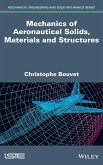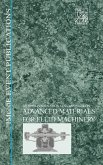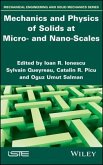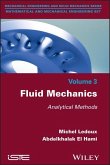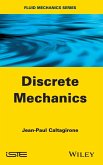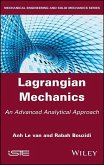Christophe Bouvet
Mechanics of Aeronautical Composite Materials
Christophe Bouvet
Mechanics of Aeronautical Composite Materials
- Gebundenes Buch
- Merkliste
- Auf die Merkliste
- Bewerten Bewerten
- Teilen
- Produkt teilen
- Produkterinnerung
- Produkterinnerung
This book presents the principles of composite laminate sizing widely used for composite structures. The focus is on aeronautics in particular, including the concepts of limit loads and ultimate loads. After a brief overview of the main composite materials used in aeronautics, the basic theory of laminated plates and the associated rupture criteria are given. The author presents two fundamental cases of the sizing of aeronautical composite structures: the calculation of the holed structures and their subsequent multi-bolt joints, and the calculation of the buckling. The concept of damage…mehr
Andere Kunden interessierten sich auch für
![Mechanics of Aeronautical Solids, Materials and Structures Mechanics of Aeronautical Solids, Materials and Structures]() Christophe BouvetMechanics of Aeronautical Solids, Materials and Structures159,99 €
Christophe BouvetMechanics of Aeronautical Solids, Materials and Structures159,99 €![Advanced Materials for Fluid Machinery Advanced Materials for Fluid Machinery]() Imeche (Institution of Mechanical Engineers)Advanced Materials for Fluid Machinery252,99 €
Imeche (Institution of Mechanical Engineers)Advanced Materials for Fluid Machinery252,99 €![Experimental Mechanics of Solids and Structures Experimental Mechanics of Solids and Structures]() Jérôme MolimardExperimental Mechanics of Solids and Structures159,99 €
Jérôme MolimardExperimental Mechanics of Solids and Structures159,99 €![Mechanics and Physics of Solids at Micro- And Nano-Scales Mechanics and Physics of Solids at Micro- And Nano-Scales]() Mechanics and Physics of Solids at Micro- And Nano-Scales160,99 €
Mechanics and Physics of Solids at Micro- And Nano-Scales160,99 €![Fluid Mechanics Fluid Mechanics]() Michel LedouxFluid Mechanics159,99 €
Michel LedouxFluid Mechanics159,99 €![Discrete Mechanics Discrete Mechanics]() Jean-Paul CaltagironeDiscrete Mechanics159,99 €
Jean-Paul CaltagironeDiscrete Mechanics159,99 €![Lagrangian Mechanics Lagrangian Mechanics]() Anh Le VanLagrangian Mechanics159,99 €
Anh Le VanLagrangian Mechanics159,99 €-
-
-
This book presents the principles of composite laminate sizing widely used for composite structures. The focus is on aeronautics in particular, including the concepts of limit loads and ultimate loads. After a brief overview of the main composite materials used in aeronautics, the basic theory of laminated plates and the associated rupture criteria are given. The author presents two fundamental cases of the sizing of aeronautical composite structures: the calculation of the holed structures and their subsequent multi-bolt joints, and the calculation of the buckling. The concept of damage tolerance is also explored, with a focus on its application for tolerance to impact damage. These notions are fundamental for understanding the specificities of the sizing of aeronautical composite structures. The book also contains corrected exercises for the reader to test their understanding of the different topics covered.
Produktdetails
- Produktdetails
- Verlag: Wiley
- Seitenzahl: 318
- Erscheinungstermin: 11. August 2017
- Englisch
- Abmessung: 240mm x 161mm x 22mm
- Gewicht: 648g
- ISBN-13: 9781786301147
- ISBN-10: 1786301148
- Artikelnr.: 48741629
- Herstellerkennzeichnung
- Libri GmbH
- Europaallee 1
- 36244 Bad Hersfeld
- gpsr@libri.de
- Verlag: Wiley
- Seitenzahl: 318
- Erscheinungstermin: 11. August 2017
- Englisch
- Abmessung: 240mm x 161mm x 22mm
- Gewicht: 648g
- ISBN-13: 9781786301147
- ISBN-10: 1786301148
- Artikelnr.: 48741629
- Herstellerkennzeichnung
- Libri GmbH
- Europaallee 1
- 36244 Bad Hersfeld
- gpsr@libri.de
Christophe Bouvet is Professor of Structural Mechanics at the ISAE-SUPAÉRO in France. His research focuses on the sizing and damage of composite structures at the Institut Clément Adler (ICA) in Toulouse, France.
Foreword ix
Preface xi
Introduction xiii
Chapter 1 Presentation of an Aeronautical Unidirectional Composite 1
1.1 Introduction 1
1.2 Carbon/epoxy composite T300/914 2
1.3 Polymers 5
Chapter 2 Characteristics of UD Ply 15
2.1 State of stress of UD ply 15
2.2 Tensile test in the l-direction 16
2.3 Tensile test along the t-direction 17
2.4 Shear test 19
2.5 General case 20
Chapter 3 Characteristics of a UD Ply in a Given Direction 27
3.1 Off-axis tensile test 27
Chapter 4 Fracture of a Laminated Composite 37
4.1 Fracture of a UD ply 37
4.1.1 Longitudinal tension 37
4.1.2 Longitudinal compression 40
4.1.3 Transverse tension 42
4.1.4 Transverse compression 43
4.1.5 In-plane shear 44
4.2 Fracture of a laminate 46
Chapter 5 Fracture Criteria of a UD Ply 49
5.1 Maximum stress fracture criterion 50
5.2 Maximum strain fracture criterion 54
5.3 Hill's criterion 58
5.4 Tsai-Wu criterion 65
5.5 Yamada-Sun criterion 70
5.6 Conclusion 71
Chapter 6 Membrane Behavior of a Laminated Composite Plate 73
6.1 Generalities and notations 73
6.2 Membrane behavior, bending behavior and mirror symmetry 75
6.3 Resultant forces 78
6.4 Displacement field, stress field and strain field 80
6.5 Tension / shear coupling 83
Chapter 7 Bending Behavior of a Laminated Composite Plate 97
7.1 Notations 97
7.2 Resultant moments 97
7.3 Displacement field, stress field and strain field 99
7.4 Bending/twisting coupling 105
Chapter 8 The Fracture Criterion of a Laminate 115
8.1 The sizing criterion 115
8.2 Test on a composite structure 117
8.3 Sizing principle 119
8.4 Sizing a given structure for a given loading 119
8.5 Optimal structure for a given load 131
Chapter 9 Damage Tolerance 139
9.1 The principle of damage tolerance 139
9.2 Damage during impact and compression after impact 144
9.3 Sizing for impact damage tolerance 148
Chapter 10 Interlaminar and Out-of-Plane Shear Stress 151
10.1 Tension of a cross-ply laminate [0,90]s 151
10.2 Tension of a cross-ply laminate [45,-45]s 153
10.3 Out-of-plane shear stress 154
Chapter 11 Holed and Bolted Plates 157
11.1 Calculating holed composite plates 157
11.2 Calculating the multi-bolt composite joints 167
Chapter 12 Buckling 179
12.1 Reminder surrounding beam buckling 179
12.2 Buckling of plates under compression 180
12.3 Plate buckling under shear loading 186
Chapter 13 Miscellaneous Rules for Stacking 189
Chapter 14 Exercises 191
14.1 Experimental determination of the characteristics of a UD material 191
14.2 Fracture of a laminate 193
14.3 Shear modulus 194
14.4 Optimization of stacking sequence 195
14.5 Composite tube 195
14.6 Laminate calculation without calculation 196
14.7 Sandwich beam under bending 197
14.8 Laminate plate under compression 200
14.9 Tube under torsion/internal pressure 203
14.10 Optimization of a fabric with a strain fracture criterion 204
14.10.1 Part 1: preamble 204
14.10.2 Part 2: quasi-isotropic stacking sequence 205
14.10.3 Part 3: stacking sequence optimization 206
14.10.4 Part 4: stacking sequence optimization under bending 206
14.11 Open hole tensile test 206
14.12 Multi-bolt composite joint 209
Chapter 15 Solutions to the Exercises 211
15.1 Experimental determination of the characteristics of a UD material 211
15.2 Fracture of a laminate 219
15.3 Shear modulus 225
15.4 Optimization of stacking sequence 229
15.5 Composite tube 233
15.6 Laminate calculation without calculation 240
15.7 Sandwich beam under bending 242
15.8 Laminate plate under compression 253
15.9 Tube under torsion/internal pressure 263
15.10 Optimization of a fabric with a strain fracture criterion 266
15.11 Open hole tensile test 276
15.12 Multi-bolt composite joint 280
Bibliography 289
Index 293
Preface xi
Introduction xiii
Chapter 1 Presentation of an Aeronautical Unidirectional Composite 1
1.1 Introduction 1
1.2 Carbon/epoxy composite T300/914 2
1.3 Polymers 5
Chapter 2 Characteristics of UD Ply 15
2.1 State of stress of UD ply 15
2.2 Tensile test in the l-direction 16
2.3 Tensile test along the t-direction 17
2.4 Shear test 19
2.5 General case 20
Chapter 3 Characteristics of a UD Ply in a Given Direction 27
3.1 Off-axis tensile test 27
Chapter 4 Fracture of a Laminated Composite 37
4.1 Fracture of a UD ply 37
4.1.1 Longitudinal tension 37
4.1.2 Longitudinal compression 40
4.1.3 Transverse tension 42
4.1.4 Transverse compression 43
4.1.5 In-plane shear 44
4.2 Fracture of a laminate 46
Chapter 5 Fracture Criteria of a UD Ply 49
5.1 Maximum stress fracture criterion 50
5.2 Maximum strain fracture criterion 54
5.3 Hill's criterion 58
5.4 Tsai-Wu criterion 65
5.5 Yamada-Sun criterion 70
5.6 Conclusion 71
Chapter 6 Membrane Behavior of a Laminated Composite Plate 73
6.1 Generalities and notations 73
6.2 Membrane behavior, bending behavior and mirror symmetry 75
6.3 Resultant forces 78
6.4 Displacement field, stress field and strain field 80
6.5 Tension / shear coupling 83
Chapter 7 Bending Behavior of a Laminated Composite Plate 97
7.1 Notations 97
7.2 Resultant moments 97
7.3 Displacement field, stress field and strain field 99
7.4 Bending/twisting coupling 105
Chapter 8 The Fracture Criterion of a Laminate 115
8.1 The sizing criterion 115
8.2 Test on a composite structure 117
8.3 Sizing principle 119
8.4 Sizing a given structure for a given loading 119
8.5 Optimal structure for a given load 131
Chapter 9 Damage Tolerance 139
9.1 The principle of damage tolerance 139
9.2 Damage during impact and compression after impact 144
9.3 Sizing for impact damage tolerance 148
Chapter 10 Interlaminar and Out-of-Plane Shear Stress 151
10.1 Tension of a cross-ply laminate [0,90]s 151
10.2 Tension of a cross-ply laminate [45,-45]s 153
10.3 Out-of-plane shear stress 154
Chapter 11 Holed and Bolted Plates 157
11.1 Calculating holed composite plates 157
11.2 Calculating the multi-bolt composite joints 167
Chapter 12 Buckling 179
12.1 Reminder surrounding beam buckling 179
12.2 Buckling of plates under compression 180
12.3 Plate buckling under shear loading 186
Chapter 13 Miscellaneous Rules for Stacking 189
Chapter 14 Exercises 191
14.1 Experimental determination of the characteristics of a UD material 191
14.2 Fracture of a laminate 193
14.3 Shear modulus 194
14.4 Optimization of stacking sequence 195
14.5 Composite tube 195
14.6 Laminate calculation without calculation 196
14.7 Sandwich beam under bending 197
14.8 Laminate plate under compression 200
14.9 Tube under torsion/internal pressure 203
14.10 Optimization of a fabric with a strain fracture criterion 204
14.10.1 Part 1: preamble 204
14.10.2 Part 2: quasi-isotropic stacking sequence 205
14.10.3 Part 3: stacking sequence optimization 206
14.10.4 Part 4: stacking sequence optimization under bending 206
14.11 Open hole tensile test 206
14.12 Multi-bolt composite joint 209
Chapter 15 Solutions to the Exercises 211
15.1 Experimental determination of the characteristics of a UD material 211
15.2 Fracture of a laminate 219
15.3 Shear modulus 225
15.4 Optimization of stacking sequence 229
15.5 Composite tube 233
15.6 Laminate calculation without calculation 240
15.7 Sandwich beam under bending 242
15.8 Laminate plate under compression 253
15.9 Tube under torsion/internal pressure 263
15.10 Optimization of a fabric with a strain fracture criterion 266
15.11 Open hole tensile test 276
15.12 Multi-bolt composite joint 280
Bibliography 289
Index 293
Foreword ix
Preface xi
Introduction xiii
Chapter 1 Presentation of an Aeronautical Unidirectional Composite 1
1.1 Introduction 1
1.2 Carbon/epoxy composite T300/914 2
1.3 Polymers 5
Chapter 2 Characteristics of UD Ply 15
2.1 State of stress of UD ply 15
2.2 Tensile test in the l-direction 16
2.3 Tensile test along the t-direction 17
2.4 Shear test 19
2.5 General case 20
Chapter 3 Characteristics of a UD Ply in a Given Direction 27
3.1 Off-axis tensile test 27
Chapter 4 Fracture of a Laminated Composite 37
4.1 Fracture of a UD ply 37
4.1.1 Longitudinal tension 37
4.1.2 Longitudinal compression 40
4.1.3 Transverse tension 42
4.1.4 Transverse compression 43
4.1.5 In-plane shear 44
4.2 Fracture of a laminate 46
Chapter 5 Fracture Criteria of a UD Ply 49
5.1 Maximum stress fracture criterion 50
5.2 Maximum strain fracture criterion 54
5.3 Hill's criterion 58
5.4 Tsai-Wu criterion 65
5.5 Yamada-Sun criterion 70
5.6 Conclusion 71
Chapter 6 Membrane Behavior of a Laminated Composite Plate 73
6.1 Generalities and notations 73
6.2 Membrane behavior, bending behavior and mirror symmetry 75
6.3 Resultant forces 78
6.4 Displacement field, stress field and strain field 80
6.5 Tension / shear coupling 83
Chapter 7 Bending Behavior of a Laminated Composite Plate 97
7.1 Notations 97
7.2 Resultant moments 97
7.3 Displacement field, stress field and strain field 99
7.4 Bending/twisting coupling 105
Chapter 8 The Fracture Criterion of a Laminate 115
8.1 The sizing criterion 115
8.2 Test on a composite structure 117
8.3 Sizing principle 119
8.4 Sizing a given structure for a given loading 119
8.5 Optimal structure for a given load 131
Chapter 9 Damage Tolerance 139
9.1 The principle of damage tolerance 139
9.2 Damage during impact and compression after impact 144
9.3 Sizing for impact damage tolerance 148
Chapter 10 Interlaminar and Out-of-Plane Shear Stress 151
10.1 Tension of a cross-ply laminate [0,90]s 151
10.2 Tension of a cross-ply laminate [45,-45]s 153
10.3 Out-of-plane shear stress 154
Chapter 11 Holed and Bolted Plates 157
11.1 Calculating holed composite plates 157
11.2 Calculating the multi-bolt composite joints 167
Chapter 12 Buckling 179
12.1 Reminder surrounding beam buckling 179
12.2 Buckling of plates under compression 180
12.3 Plate buckling under shear loading 186
Chapter 13 Miscellaneous Rules for Stacking 189
Chapter 14 Exercises 191
14.1 Experimental determination of the characteristics of a UD material 191
14.2 Fracture of a laminate 193
14.3 Shear modulus 194
14.4 Optimization of stacking sequence 195
14.5 Composite tube 195
14.6 Laminate calculation without calculation 196
14.7 Sandwich beam under bending 197
14.8 Laminate plate under compression 200
14.9 Tube under torsion/internal pressure 203
14.10 Optimization of a fabric with a strain fracture criterion 204
14.10.1 Part 1: preamble 204
14.10.2 Part 2: quasi-isotropic stacking sequence 205
14.10.3 Part 3: stacking sequence optimization 206
14.10.4 Part 4: stacking sequence optimization under bending 206
14.11 Open hole tensile test 206
14.12 Multi-bolt composite joint 209
Chapter 15 Solutions to the Exercises 211
15.1 Experimental determination of the characteristics of a UD material 211
15.2 Fracture of a laminate 219
15.3 Shear modulus 225
15.4 Optimization of stacking sequence 229
15.5 Composite tube 233
15.6 Laminate calculation without calculation 240
15.7 Sandwich beam under bending 242
15.8 Laminate plate under compression 253
15.9 Tube under torsion/internal pressure 263
15.10 Optimization of a fabric with a strain fracture criterion 266
15.11 Open hole tensile test 276
15.12 Multi-bolt composite joint 280
Bibliography 289
Index 293
Preface xi
Introduction xiii
Chapter 1 Presentation of an Aeronautical Unidirectional Composite 1
1.1 Introduction 1
1.2 Carbon/epoxy composite T300/914 2
1.3 Polymers 5
Chapter 2 Characteristics of UD Ply 15
2.1 State of stress of UD ply 15
2.2 Tensile test in the l-direction 16
2.3 Tensile test along the t-direction 17
2.4 Shear test 19
2.5 General case 20
Chapter 3 Characteristics of a UD Ply in a Given Direction 27
3.1 Off-axis tensile test 27
Chapter 4 Fracture of a Laminated Composite 37
4.1 Fracture of a UD ply 37
4.1.1 Longitudinal tension 37
4.1.2 Longitudinal compression 40
4.1.3 Transverse tension 42
4.1.4 Transverse compression 43
4.1.5 In-plane shear 44
4.2 Fracture of a laminate 46
Chapter 5 Fracture Criteria of a UD Ply 49
5.1 Maximum stress fracture criterion 50
5.2 Maximum strain fracture criterion 54
5.3 Hill's criterion 58
5.4 Tsai-Wu criterion 65
5.5 Yamada-Sun criterion 70
5.6 Conclusion 71
Chapter 6 Membrane Behavior of a Laminated Composite Plate 73
6.1 Generalities and notations 73
6.2 Membrane behavior, bending behavior and mirror symmetry 75
6.3 Resultant forces 78
6.4 Displacement field, stress field and strain field 80
6.5 Tension / shear coupling 83
Chapter 7 Bending Behavior of a Laminated Composite Plate 97
7.1 Notations 97
7.2 Resultant moments 97
7.3 Displacement field, stress field and strain field 99
7.4 Bending/twisting coupling 105
Chapter 8 The Fracture Criterion of a Laminate 115
8.1 The sizing criterion 115
8.2 Test on a composite structure 117
8.3 Sizing principle 119
8.4 Sizing a given structure for a given loading 119
8.5 Optimal structure for a given load 131
Chapter 9 Damage Tolerance 139
9.1 The principle of damage tolerance 139
9.2 Damage during impact and compression after impact 144
9.3 Sizing for impact damage tolerance 148
Chapter 10 Interlaminar and Out-of-Plane Shear Stress 151
10.1 Tension of a cross-ply laminate [0,90]s 151
10.2 Tension of a cross-ply laminate [45,-45]s 153
10.3 Out-of-plane shear stress 154
Chapter 11 Holed and Bolted Plates 157
11.1 Calculating holed composite plates 157
11.2 Calculating the multi-bolt composite joints 167
Chapter 12 Buckling 179
12.1 Reminder surrounding beam buckling 179
12.2 Buckling of plates under compression 180
12.3 Plate buckling under shear loading 186
Chapter 13 Miscellaneous Rules for Stacking 189
Chapter 14 Exercises 191
14.1 Experimental determination of the characteristics of a UD material 191
14.2 Fracture of a laminate 193
14.3 Shear modulus 194
14.4 Optimization of stacking sequence 195
14.5 Composite tube 195
14.6 Laminate calculation without calculation 196
14.7 Sandwich beam under bending 197
14.8 Laminate plate under compression 200
14.9 Tube under torsion/internal pressure 203
14.10 Optimization of a fabric with a strain fracture criterion 204
14.10.1 Part 1: preamble 204
14.10.2 Part 2: quasi-isotropic stacking sequence 205
14.10.3 Part 3: stacking sequence optimization 206
14.10.4 Part 4: stacking sequence optimization under bending 206
14.11 Open hole tensile test 206
14.12 Multi-bolt composite joint 209
Chapter 15 Solutions to the Exercises 211
15.1 Experimental determination of the characteristics of a UD material 211
15.2 Fracture of a laminate 219
15.3 Shear modulus 225
15.4 Optimization of stacking sequence 229
15.5 Composite tube 233
15.6 Laminate calculation without calculation 240
15.7 Sandwich beam under bending 242
15.8 Laminate plate under compression 253
15.9 Tube under torsion/internal pressure 263
15.10 Optimization of a fabric with a strain fracture criterion 266
15.11 Open hole tensile test 276
15.12 Multi-bolt composite joint 280
Bibliography 289
Index 293


